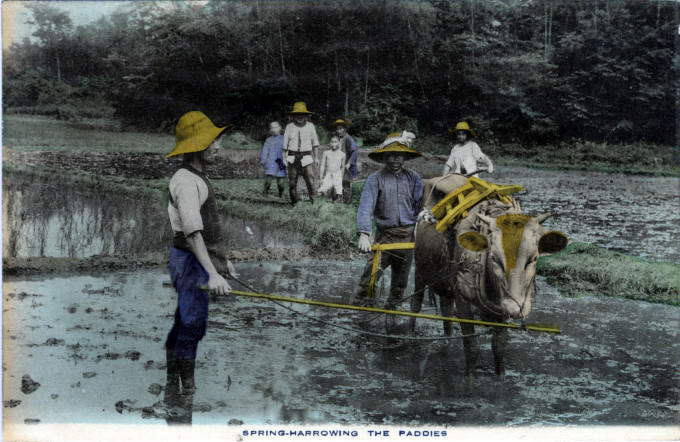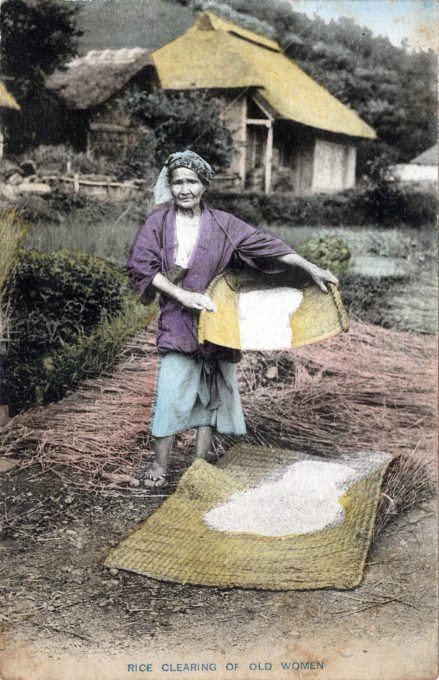See also:
Rice culture, c. 1910.
Inari Fushimi Shrine, c. 1910.
“Village life – competitive charm”, Nohonshugi (“Agrarian fundamentalism”) propaganda postcard, c. 1940.
“In Japanese agriculture, rice carries incalculable weight compared with other crops. It is no exaggeration to say that the maintenance of complete rice self-sufficiency is the sole guarantee to agriculture and farming households in Japan.
“Rice farming in Japan, with a history of 2,300 years behind it, has greatly influenced all areas of national life, including social order, religious worship, festivals, food, clothings and housing, thus molding the prototype of Japanese culture.
“In addition, Japanese agriculture and its farming household economy have traditionally developed around rice, and other sectors of agriculture, such as livestock farming and horticulture, are actually based on rice.”
– Zenchu Farm News, Vol. 5, Tokyo, January 1987

“Spring-harrowing the paddies”, c. 1920. In pre-war days, this preparation – the tilling or plowing of the paddy – was done by animal and manual human labor.
“The two most important events of the year in the rural districts of Japan, and the busiest occasions for the farmers, are the taue [lit. ‘field planting’] in early summer and the rice harvest in autumn.
“By taue is meant the work of transplanting rice-seedlings from a rice nursery to the main paddy-fields. The time for this work usually falls between the latter half of June and the early part of July irrespective of the kinds of rice … Questions of available labour, damage by insects, and damages from storms and floods also play a part in determining the time for transplantation.
“Smoking of country brothers”, c. 1920, sitting in front of a rice straw shelter for protection from the weather.
“… The skill in transplanting has a considerable effect on the autumn crop. Utmost care and long experience alone enable one to acquire this skill, without which a farmer cannot be said to be fully qualified for the profession.
“To transplant the seedlings efficiently, the bearing of the body must be first carefully studied. The seedlings are arranged by the left hand and planted with a quick movement of the right. Agile movements of fingers, especially the middle finger, are required to insert the roots of the seedlings shallowly but with certain firmness into the ground. The stepping movement, too, must be uniform and straight. If the bearing of the body is not correct, and the stepping movement irregular, the planter is liable to insert the seedlings into his own footmarks, and this sometimes causes an unfavourable crop in autumn.
“During the season of rice-transplantation, rural districts all over Japan become lively, all the farmers, their wives and daughters being neatly attired for this important occasion. Peasant-women wearing sedge-sunshades, crouching here and there in the wide expanse of mirror-like rice-fields, present a charming picture; and to hear the rustic tune of the ‘rice-transplanting song’ they sing is a pleasantly novel experience.
“… The ‘rice-transplanting song’ or in Japanese ‘Taue-uta’, occupies one of the most important positions among the Japanese folk-songs, and is of very ancient origin. Among the ‘Taue-uta’ there are found many excellent pieces, strangely gay and yet melancholy, which leave a deep lingering impression on the hearer’s mind.”
– “Rice-planting, Japanese Farmers’ Busy Season”, Travel in Japan, Vol. 4 No.2, 1938

Transplanting rice-shoots, c. 1920. From the article above: “To transplant the seedlings efficiently, the bearing of the body must be first carefully studied. If the bearing of the body is not correct, and the stepping movement irregular, the planter is liable to insert the seedlings into his own footmarks, and this sometimes causes an unfavourable crop in autumn.
“The history of rice and rice agriculture in the Japanese archipelago is not a long one. It is believed to have arrived in Japan’s southern island of Kyushu at the tail end of the Jomon period (about 400 BC), the short-grained japonica variety that’s common in southern China and on the Korean Peninsula. Rice-growing seems to have come first to the northern part of the island of Kyushu in western Japan. Since Japan’s mild and humid climate is good for growing this crop, it spread to the rest of Kyushu and to the other islands. However, rice doesn’t grow well where summers are too cool. In the not-too-distant past, rice crops failed on many occasions in the northern part of Honshu, Japan’s main island, causing great suffering for the people living there.
“For the pre-WWII Japanese farmer, the rice production cycle began with the careful selection of seeds for planting into prepared seed-beds. The preparation of the paddy field itself began with the tilling or plowing of the land by means of manual labor. The operation of transplanting the rice from the seed-beds to the paddies was viewed as the crucial point, requiring the mobilization of all available labor to complete it in time to take advantage of weather and water supply conditions.
“The transplanting teams moved through the fields with the backbreaking task of setting each individual seedling in its place. After transplanting, the fields needed to be flooded to a greater depth, allowing the seedlings to grow in the standing water which provided nutrients and kept down weed growth. All being well, as the heads of grain formed and ripened, the water level would be allowed to fall in preparation for the fall harvest. Once again, all available labor was required to cut the plants in the field, and then thresh, hull and polish the grain to make it ready for consumption, sale or storage.
- Rice picking of country girl, c. 1920.
- Autumn drying rice, c. 1920.
“Because rice can be kept in storage, village leaders and other powerful people started building up large stores of rice, which led to a gap between rich and poor. Rice was also used to pay taxes in Japan for many centuries, until a little over a hundred years ago. After the end of the Tokugawa bakufu upon the Meiji Restoration of 1868, Japanese agriculture was dominated by a tenant farming system. The Meiji government based its industrialization program on tax revenues from private land ownership, and the Land Tax Reform of 1873 increased the process of landlordism, with many farmers having their land confiscated due to inability to pay the new taxes.
“The situation was worsened by the deflationary Matsukata Fiscal Policy of 1881-1885, which severely depressed rice prices, leading to further bankruptcies, and even to large scale rural uprisings against the government. By the end of the Meiji period, over 67% of all peasant families were driven into tenancy, and farm productivity stagnated. As tenants were forced to pay over half their crop as rent, they were often forced to send wives and daughters to textile mills or to sell daughters into prostitution to pay for taxes.
“Gradually, with the development of cash crops to supplement the mainstay of rice, and the growth of capitalism in general from the turn of the twentieth century onwards, agricultural cooperatives and the government took over the role by providing farm subsidies, loans, and education in new agricultural techniques. The first agricultural cooperatives were established in 1900 as a means of modernizing Japanese agriculture and adapting it to a cash economy. These cooperatives served in rural areas as credit unions, purchasing cooperatives and assisted in the marketing and sales of farm products.
“Not only were the Imperial Family of Japan and the zaibatsu major landowners, but until 1928, an income tax requirement severely limited the right to vote, limiting seats in the Diet of Japan only to people of wealth. After the Rice Riots of 1918, many peasants came under the influence of the urban labor movement with socialist, communist and/or agrarian ideas. In 1922, the Nihon Nomin Kumiai (Japan Farmer’s Union) was formed for collective bargaining for cultivator rights and reduced rents.”
– Wikipedia








